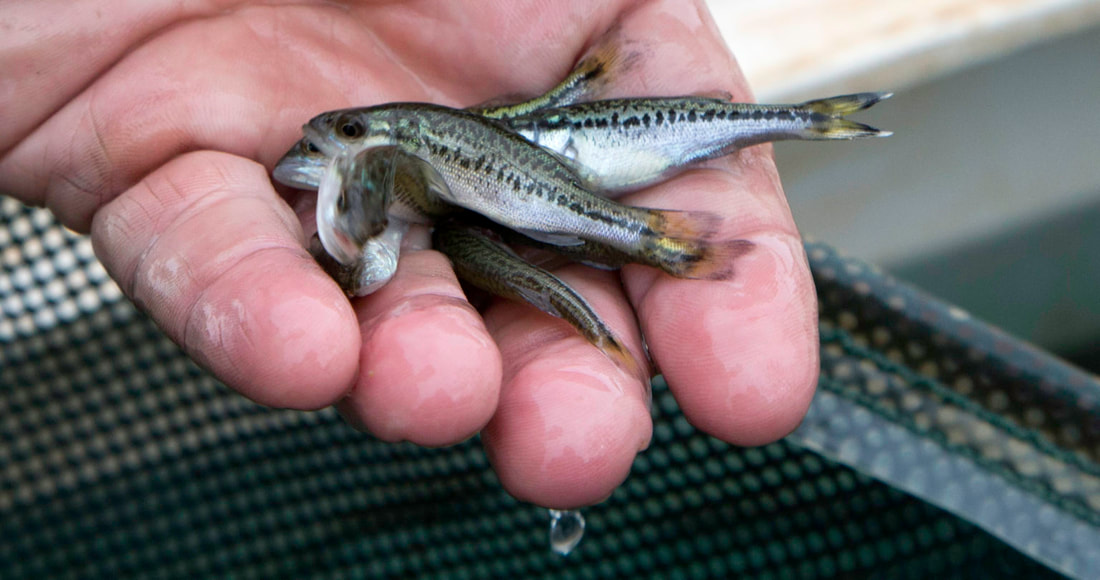Tiger Bass bring a new brand of genetics to Grand Lake O’ the CherokeesBy Kelly Bostian
For the CCOF A new beast is swimming the waters of northeast Oklahoma and it could spread to other lakes across the state. If the Oklahoma Department of Wildlife Conservation likes what it sees, that is. A load of 93,000 Tiger Bass fingerlings hit the waters of Grand Lake O’ the Cherokees late last week. The name of the fish is a trademarked moniker of the American Sport Fish Hatchery in Montgomery, Ala. They came at no small expense and with big expectations. According to American Sport Fish, the bass is a selected pure F-1, the designation for the first-generation mix of two sub-species. The genetic cross brings northern-strain aggressiveness and cold tolerance and Florida-strain growth potential of up to 2 pounds per year. The hatchery claims the hybrids, “created through a selective breeding program,” make trophy bass. The fish grow faster and are more aggressive than natural cross-breeds or most state agency mixes, they claim. With the aid of private and municipal donations totaling $40,0000, the first batch hit the water late last week. About 30,000 fingerlings each now are swimming the upper stretches of the Duck, Horse, and Honey creek tributaries. The number works out to two roughly fish per acre for the 46,000-acre reservoir. Josh Johnston, Wildlife Department northeast region fisheries supervisor, said he hopes to repeat these stockings for 10 years. Florida-Oklahoma history Johnston emphasized the Tiger Bass program is not meant to boost the nationally ranked bass fishing lake’s population. What they want to build is “trophy potential.” “We want to push Grand Lake to a place where the big bass in a tournament is not 6.83 (pounds) but it’s 10.24 or 11.15, something like that. That’s just unheard of now when you get this far north. That would push this lake to a whole new level if you had that trophy potential,” he said. The Florida-strain largemouth bass is a big deal nationwide. Big, aggressive bass boost fishing interest and thus tourism and conservation dollars from fishing license and gear sales. However, Florida bass are less aggressive biters in cold weather and young Florida bass have trouble surviving cold Oklahoma winters. In the 1980s many state agencies across the South and Midwest stocked Florida-strain bass in almost every lake, including Oklahoma. However, later studies found that the fingerlings simply weren’t surviving in most lakes in the northern half of this state. Southern lakes like Arbuckle, Sardis, McGee Creek, Broken Bow, and Cedar, among others, started consistently producing larger bass. The state still serves dozens of Oklahoma lakes with a Florida-strain bass stocking program through its hatcheries. Many of the state’s record-setting bass are a result of that program. Three years ago, Johnston, proposed putting Tiger Bass in Grand, but the effort hit hurdles. So, he devised a sort of compromise stocking study. Rather than stock fingerlings, the state hatchery system devoted extra Florida-strain brood stock to a three-year stocking program at Grand. The large, mature, fish could immediately spawn, survive Grand Lake winters, and would naturally share their genes, Johnston said. The last of the big brood fish hit the Grand Lake early this year. Genetic sampling and study of those fish will continue, Johnston said. The tale of Tigers As the Major League Fishing Redcrest Championship approached in March of 2022, legendary professional angler Kevin VanDam reached out to local biologists for ideas on how his non-profit foundation could help boost Grand Lake. He liked the Tiger Bass idea. With $5,000 from VanDam’s foundation and a match from the Oklahoma Wildlife Conservation Foundation, plus $5,000 from the Grove Convention and Tourism Bureau, $5,000 from Whiskey Point on Grand Lake, $5,000 from Southstone Construction in Jenks, $5,000 from the Swank Family Foundation in Tulsa and $10,000 from Flying Squirrel Farms in Claremore, the $40,000 needed for a Tiger Bass program launch arrived. Johnston emphasized that the results from the Florida brood stock and the Tiger Bass stock won’t be known for several years. However, the research could break new ground for a new trophy potential for Grand and other northern latitude lakes. DNA sampling and measuring of Grand Lake bass in coming years will give biologists an idea of growth rates and DNA comparisons of northern largemouth bass, the stocked Florida bass, offspring of those Florida basses, as well as the Tiger Bass and their offspring. “It’s going to be a very cool project,” he said. “We’re excited to get this going.” Kelly Bostian is an independent journalist writing for The Conservation Coalition of Oklahoma Foundation, a 501c3 non-profit dedicated to education and outreach on conservation issues facing Oklahomans. To learn more about what we do and to support Kelly’s work, see the About the CCOF page.
0 Comments
Leave a Reply. |
Archives
May 2024
Categories
All
|
Conservation Coalition of Oklahoma
P.O. Box 2751
Oklahoma City, OK 73101
[email protected]



